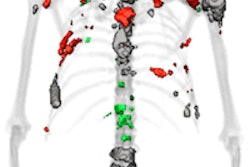
Researchers from the University of British Columbia (UBC) are reporting early success in developing a novel T2-based MRI technique that uses water content in prostate tissue to detect and grade cancer. The method outperformed several other MRI parameters, according to a study published in the August issue of Radiology.
In testing, luminal water fraction -- the measurement of water distribution within tissue -- was the most accurate factor in diagnosing and grading prostate cancer. It also doesn't require a contrast agent.
"If we use only a single parameter for tumor detection, luminal water fraction provides the highest accuracy," said lead author Shirin Sabouri, a doctoral candidate in UBC's department of physics and astronomy. "But we can obtain even higher accuracy when other parameters of this technique are combined."
MRI and water
The foundation for luminal water imaging began several years ago with the advent of myelin water MR imaging to view water distribution within brain tissue. One of the key developers of myelin water imaging was Dr. Alex MacKay, a professor of radiology at UBC.
"This technique has been very successful and used for many years to look at myelin content and myelin damage in multiple sclerosis patients and other neurodegenerative diseases," said senior author Piotr Kozlowski, PhD, an associate professor at UBC and associate director of the UBC MRI Research Centre. "When we started to work on prostate tissue, the idea was that we could apply a similar [MRI] technique to look at the distribution of water within prostatic tissue."
 Shirin Sabouri, doctoral candidate at UBC.
Shirin Sabouri, doctoral candidate at UBC.In the case of very high-grade tumors, the luminal space in the prostate almost disappears, Kozlowski explained. So, the goal with luminal water imaging is to distinguish between malignant and benign lesions and different pathological grades of the tumors. Essentially, when the water content is high, the tissue is normal; decreased water content, on the other hand, could indicate cancer (Radiology, August 2017, Vol. 284:2, pp. 451-459).
"If you consider prostatic tissue as a mixture of stromal tissue and tiny compartments filled with water, tissues of different pathological stages of prostate cancer have different types of composition of water compartments," Sabouri said. "With MRI, we are measuring the water content inside these tiny compartments. When we measure this water content, the higher it is, the more likely it is for the tissue to be normal. As the water content goes lower, it can indicate malignancy because the tissue is losing its normal luminal structure."
For the study, the UBC researchers recruited 18 consecutive patients (median age, 65.5 years; range, 58-80.3 years) between January 2015 and January 2016 who were referred to the Vancouver General Hospital Urology Clinic for prostate cancer. Noncontrast-enhanced MRI exams were performed on a 3-tesla scanner (Philips Healthcare) with combined endorectal and pelvic phased-array coils shortly before radical prostatectomy.
The T2 MR imaging protocol included seven parameters, such as distinguishable T2 components; the geometric mean T2 of the entire distribution; luminal water fraction; and areas under the short and long components. The researchers then generated maps of these parameters for every section of the prostate, with average values calculated for a total of 378 images. The data included 226 nonmalignant and 152 malignant regions of interest, which were manually outlined on histologic images.
Parameter performance
In reviewing and comparing the parameters, Sabouri and colleagues found that luminal water fraction achieved the highest correlation (-0.78 ± 0.11, p > 0.001) with subjects' Gleason scores, making it the most effective way to detect and grade tumors. The receiver operating characteristic (ROC) analysis for luminal water fraction also demonstrated high accuracy for tumor detection, with the highest area under the ROC curve of 0.97 in the peripheral zone of the prostate.
When the researchers combined average values of four MR parameters -- the geometric mean T2, T2 of the short component, the areas under the short component, and the number of components -- the combination increased the ability to differentiate between malignant and nonmalignant tissue.
"For the purpose of grading a tumor, luminal water fraction showed us the highest correlation, but for the purpose of the detection of tumors, the highest accuracy is obtained when we use multiple parameters," Sabouri added.
Because the luminal water technique is in the early stages of development, the approach has not yet been used in daily clinical diagnoses.
"The idea is to make it more radiologist user-friendly, but we are not there yet. We are working toward that," Kozlowski said. "Mainly, we want to make the data acquisition shorter than it is right now, because it takes about 11 minutes to collect all the data. Second of all, we are thinking about how to analyze the data in a way that is easier for the radiologist to interpret it."
One of the advantages of this MRI technique is that it does not require contrast, Sabouri said, making it an alternative for patients who are at risk of receiving or allergic to contrast agents or those who have a hip implant, which would result in suboptimal diffusion weighted imaging. Since submitting this paper, the researchers have expanded their study to include 35 patients, with plans to collect more data to validate the early results.



















